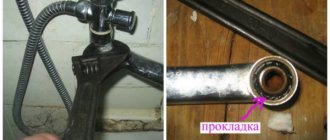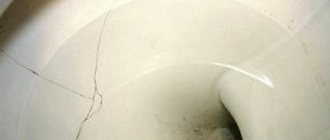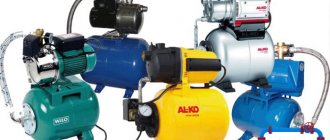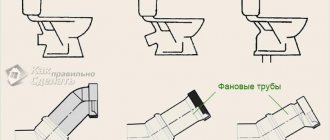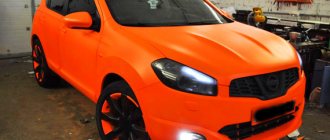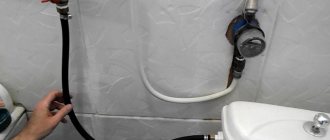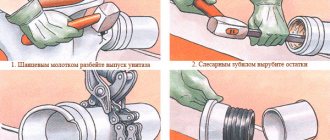When developing new car models, all designers at any time try to achieve a smooth ride and silence while driving. The silent operation of the entire structure while driving gives the car solidity and serves as an indicator that all components are working properly, the parts are tightly tightened, and the welding of the car muffler and its seams is done with high quality.
If a crack has formed in the muffler of a car's exhaust system, it can be welded.
How to weld a car muffler yourself
When developing new car models, all designers at any time try to achieve a smooth ride and silence while driving. The silent operation of the entire structure while driving gives the car solidity and serves as an indicator that all components are working properly, the parts are tightly tightened, and the welding of the car muffler and its seams is done with high quality.
If a crack has formed in the muffler of a car's exhaust system, it can be welded.
How does a muffler failure manifest itself?
The most vulnerable part in a car is the housing of the unit that dampens the sound of the engine. Since the muffler is located under the bottom, at the closest point to the road surface, it is subject to constant internal and external influences and often malfunctions. This is immediately determined by ear. The car begins to “growl” or “squeak” when the engine is running.
It may be empty inside, but is often filled with noise-reducing, heat-resistant materials, such as mineral wool. The design depends on the manufacturer and time of production of the car.
A conventional muffler is attached to the bottom using movable clamps connected to each other, or special washers made of rubber that can withstand heavy loads. This fastening ensures that the entire assembly is located at the required distance from the bottom of the car, as well as its silent operation during vibrations during exhaust. If these connections are damaged when driving, a systematic knocking sound appears in the luggage compartment area.
The problem can be identified by the smell of spent gasoline in the cabin.
Exhaust gases with temperatures up to +80…+100°C enter the muffler. In winter cold, spring or autumn, when it is only +15...+20°C outside, condensation begins to form inside the element, which causes corrosion of the metal. First of all, welding seams are susceptible to this - they begin to burn out, become covered with rust, cracks, crevices and through holes form through which gas escapes noisily.
This problem can be identified by the appearance of brownish stripes and dots at the welding points on the surface of the part. In addition, the smell of spent gasoline may appear in the cabin.
If there is an internal malfunction or burnout of the filler, the color of the exhaust gases may change. They become darker or even black.
From the outside, the unit is affected by various reagents that are used to treat roads. Mechanical damage is common when driving over uneven roads, potholes and deep holes. As a result of impacts, through damage to the sheet metal is formed, leading to a change in sound during the exhaust. For example, growling noises and “shots” can occur when you suddenly increase or decrease speed.
Repair using cold welding
The most effective, not requiring much labor and special tools, and relatively inexpensive way to repair a muffler is the use of cold welding (CW). This is a mixture consisting of two components - fiberglass and resin. When they are mixed with a special reagent, hardening occurs.
The resulting mass adheres firmly to the surface of parts made of various materials. They are securely fastened to each other as the mixture hardens.
This composition can be used to seal small holes and cracks. A completely thickened and dried mass forms a solid substance that can withstand the aggressive influence of temperature and moisture, as well as various mechanical influences.
Pros and cons of this method
Some car enthusiasts do not understand the benefits of using CS. Out of habit, they seal holes and cracks using classical methods of joining metals, such as welding.
Cold welding is easy to use.
Advantages of working with HS:
- Easy to use. Accessible even to novice car enthusiasts.
- No need for highly specialized and expensive tools.
- Safety. Does not require the interaction of high temperatures and electricity.
- Plastic. In the first 5-10 minutes of work (depending on the components and manufacturer), the resulting substance has a plasticine-like state. The mass or weld seam can be given any shape.
- Penetration even into the smallest cavities when adjoining or covering elements. Having gone through the full stage of hardening, it forms a reliable connection with high impact resistance, heat resistance, resistance to moisture and other aggressive elements.
- Sealing the insides of the unit. Exhaust gases can only be discharged through the exhaust pipe.
- Low cost.
- Possibility to repair the muffler even on the road.
Disadvantages of the cold welding method:
- The composition must be used before the specified period. After this, it is impossible to work with the mass. Often the composition remains plastic for only 3-10 minutes, and complete hardening occurs only after 24 hours.
- Sealing large holes and attaching large-scale patches is difficult.
- Due to the wide variety of mixtures, it is necessary to select the material appropriate to the occasion. It is necessary to consult a specialist or seller.
- You need to work with CS wearing rubber gloves and preferably outdoors, because the composition is toxic. Upon completion of the repair, hands must be washed thoroughly.
Part preparation
To obtain a high-quality connection, before welding, the area around the crack or hole formed is thoroughly cleaned of black deposits and rust that have formed around it. The treated surface is degreased using alcohol-containing liquids or gasoline and wiped with a dry cloth.
The muffler can be repaired with a plastic compound.
Types of cold welding
The muffler can be repaired with the following types of CS:
- Liquid composition. It is already prepared for use, packaged in special packaging or syringes. In them, the components are mixed automatically immediately before use. This type of cold welding is convenient for sealing small cracks and rusted welds, but it quickly undergoes initial hardening.
- Plastic composition. It consists of one and two components.
Is it possible to use cold welding to repair a muffler?
A good solution could be cold welding, that is, a two-component adhesive composition that, when hardened, forms a high-strength patch with good adhesive properties. The use of this method is advisable only for eliminating minor damage , such as cracks, chips, holes of a relatively regular shape. Serious multiple burns cannot be contained by cold welding alone and will require the installation of a patch (bandage) made of fiberglass or other similar material.
Muffler repair using electric welding
Before welding the muffler yourself using electric welding, you need to choose one of 2 methods:
- Weld a patch onto the damaged area or area eaten away by rust.
- Fill the hole with electrode material if welding is used or with copper wire if a semi-automatic device is used. This method is only suitable for fixing small holes.
What you need
The basic rule when working with electric welding is to disconnect the machine’s battery and inverter (if there is one) by removing the wires from them. This is done so that a short to ground does not occur and the vehicle's power supply system does not fail.
For work you need a mask and gloves, a welding machine.
To work you need:
- Mask and gloves.
- Welding machine (preferably low power). The best option is a semi-automatic machine with carbon dioxide protection. You can use 0.8-1 mm wire on it.
- A metal brush and fine sandpaper to clean the surface from dirt, carbon deposits and rust.
- Drill or grinder (angle grinder) with attachments.
- Degreasing solution for cleaning the surface from crumbs and metal dust.
- Cut pieces of tin. They should have a small gap (0.5-1 mm) to cover the hole. The thickness of the patches is no more than 2 mm.
- Hammer and chisel for removing scale. Needed to see how the seam lays down.
- High temperature resistant paint and special primer.
At the end, the welded areas must be coated with paint.
Which welding machine to use
To repair the muffler, you must use a welding machine that meets 2 basic requirements:
- the operating current is minimal;
- It is possible to use thin electrodes.
A semi-automatic machine is more suitable than a conventional electric welding unit. Its modes are suitable for working with thin metal.
Thanks to CO2 protection, there will be no overheating and oxidation of the weld, so the intact base metal will not lose strength.
Features of electric welding
If you use semi-automatic welding, the process must take place with arc separation. The seam should be applied from thick metal to thin metal.
The process must take place with arc separation.
It is necessary to monitor it for the appearance of pores. If they have formed, then this place needs to be re-welded.
Upon completion of seaming or welding of metal, it is necessary to clean the surface undergoing repair from scale and treat it with regular sandpaper.
Preparation for welding
Before welding the exhaust begins, you should prepare the surface and acquire the necessary equipment. To repair a muffler by welding, you will need:
- Welding machine. Welding of exhaust systems can be carried out by any low-power units. The most suitable would be to use a semi-automatic device with protective gas. The wire diameter for it should be in the range of 0.8-1 millimeter.
- Wire brush or sandpaper. With their help, the surface of parts is freed from rust.
- Grinder or grinder.
- Pieces of sheet metal. The size must be such that the defect is completely covered. Thickness - no more than two millimeters.
- Hammer or chisel. They will be needed after welding is completed to remove scale.
- Protective primer.
- Heat-resistant paint. It will provide additional protection from moisture.
To clean the surface of the parts you will need a degreaser.
Which welding method is better to choose for a car muffler?
The choice of muffler repair method depends on many conditions:
- it rusted or got a hole when driving over uneven surfaces;
- the unit failed on the last trip or systematic preparations for its repair have been underway for a long time;
- Is the engine working correctly?
- Is the fuel used quality?
- how financially secure and hardworking the owner is to carry out repairs on his own, etc.
It's better to turn to professionals. They know which welding method to use to repair a muffler. At the service station they will test the car and indicate the reasons for the appearance of cracks and holes. Some of them may arise due to poor performance of other machine components.
When is welding not suitable for repair?
It is not always possible to patch holes and restore rusted seams using the classical method. Especially if the defects are global.
Welding can enlarge the gaps.
Under the influence of high temperatures (when repairing mufflers by welding), you can only increase the gaps, burning the metal corroded by rust. And if some internal partitions have come off, then without cutting the body it is not always possible to get to them and weld them in their original place. In these situations, there is only one way out - buying a new node.
Reasons for muffler failure
Humidity and exposure to high temperatures contribute to the deterioration of the muffler. Corrosion forms and begins to corrode the metal of the muffler. If the car is driven on uneven terrain with a large number of potholes, then the muffler is subjected to negative effects with particular force, which is facilitated by its location.
With damage of this nature, the unpleasant sound of the engine roar increases, and exhaust gases may begin to enter the cabin. You can replace the muffler with a new one. But if the damage is minor, then welding the exhaust system, which includes a muffler, will help.
Alternative repair options
There are other methods and materials for repairing through holes and burnouts in the muffler. They are not as expensive as welding, but also not as durable and reliable. They can only be used to delay time before major repairs or purchasing a new muffler.
Using sealant
In case of minor damage and preventive sealing of the exhaust system, special compounds - sealants - are used at the joints. They are easy to use: just read the included instructions carefully and follow them strictly. These mixtures are used as an addition to welding repairs, covering the seams on top.
Sealing with protective tape
The ceramic backed fabric is easy to use and can withstand temperatures up to 1000ºC. It is moistened with water and wrapped around the muffler in 2 layers so that the material covers the damage or gap. This bandage lasts up to 3 months.
Communities › Exhaust Systems and Intake › Blog › Muffler: boil cannot be replaced
Friends, good evening everyone!
Actually, let's move directly to the question: the muffler on my car is not in the first degree of freshness, it is a little rotten. In general, the burnout occurred near the seam on the can itself, so the metal is very thin. If you take the native Ivekovsky one it costs 10-12 thousand rubles. Because there is only the original. Is it worth trying to cook? Injector or semi-automatic? Will it burn at the welding site or nearby? Maybe just scald it entirely? Or pick one from a car with the same 2.8 liter internal combustion engine?
muffler is in approximately this condition
Comments 20
The semi-automatic cooks everything, even to rust. Just first use a small current to shit (to melt) the metal, and only then go over it with a good layer, it would also be advisable to make small gussets to take the load off the seam, because there the metal will become weaker after welding, and will soon burst nearby, or burn out.
And as an option, you can even make a Glushak from scratch, and if you have non-rust steel, it will turn out to be completely eternal)))
you can weld anything, there would be something and to what purpose
Yesterday I cooked it myself, using a simple inverter, electrode 2. Little by little with oven mitts at first, then boiled it.
You cut two half rings at the end from 2-3mm steel, so that the inside can be welded to the pipe to these half rings. And from the outside you make it so that they fit inside towards the original end, but without gaps. Cook towards the end bend in a circle. Then you boil the half rings together. He walks for a long time afterwards. To make a rope, make a hole with a diameter of 50 mm on a piece of cardboard, cut the cardboard and attach both halves to the jar. I outlined the outside with a pencil and cut it off. Then you adjust the cardboards to recess them deep into the end. Using them, you then cut out the metal. You can weld with an inverter, if you have a minimum of skills, buy electrodes with a diameter of 1.6 mm MP3 at a welding store. Business for a couple of hours
How to weld a car muffler with your own hands?
The muffler is one of the most important components in modern cars. And despite its simple function, namely suppressing noise from the engine and exhaust system, it makes a big difference. As part of the exhaust system, it also reduces the amount of exhaust gases entering the atmosphere. But due to its location, it is the muffler that often becomes a victim of breakdowns.
You will often hear if there is something wrong with the muffler. Even if there is a small hole in it, the sound will immediately change. Changes in sound will be especially noticeable when driving. And the higher the speed, the more suspicious the sound. Yes, a malfunctioning muffler does not in any way affect the driving characteristics of the car, but if you do not carry out repairs, you are guaranteed to receive a fine. In addition, you will simply not be allowed to travel abroad with a faulty muffler, since they have very strict requirements for the amount of exhaust gas emissions.
Don't be so quick to worry. There are several ways to repair a muffler, from budget to expensive. And if the damage is not very serious, then you can even do the repairs yourself. In this article we will talk in detail about repair methods and the main nuances.
general information
What can cause a muffler to malfunction? Our roads are not the best, which is why stones and small debris constantly fly under the bottom. Speed bumps that need repair can also damage the metal. But the biggest problem is the water, snow and mud that exist on the roads of our cities 10 months a year. And in some cities, roads are sprinkled with chemically active reagents that damage not only shoes, but also the bottom of the car.
Muffler repair
So, the most common malfunction is the formation of through holes and cracks. Depending on their number, size and location, you can decide whether you can do the repair yourself. If there are a lot of faults, then it is better to entrust this work to servicemen, otherwise you will simply waste a lot of effort and time. Well, if a small crack has formed, you can fix it yourself. Next we will talk about repair methods.
Welding
Let's start with the most complex and difficult to do at home - welding. Welding of the muffler is entrusted only to experienced craftsmen who have been holding the torch for many years. If you cook with an inverter at an amateur level, then think ten times before cooking a muffler.
Here the whole difficulty lies in the seams. They must be absolutely airtight, rigid and durable. In addition, you may simply not know when simple welding is enough for repairs, and when additional surfacing is required. Sometimes cracks literally grow along the surface of the exhaust pipe, and in this case you won’t be able to get by with just a seam.
Even if you are confident in your abilities, you need to have a semi-professional or professional semi-automatic welding machine in your arsenal. As well as a cylinder with protective gas, special filler wire and electrodes. This is a large and bulky piece of equipment that you are unlikely to store in your garage. So we do not recommend this kind of welding at home. It’s better to take the car to a service center right away.
Sealant
But this is a simpler option. Using a special sealant, you can quite easily and quickly seal small cracks and holes. Typically, such sealants are very resistant to high temperatures and allow you to carry out repairs in any conditions, even near your own entrance. Additionally, you can increase the sealing of the exhaust system, which is also good.
Repairing exhaust system components using sealant is one of the most budget-friendly options. This is why unscrupulous services often resort to this method. The service is required to do full-fledged high-quality welding, and not to fill the cracks with cheap sealant. Pay attention to this if you decide to have your car serviced.
So, to make repairs, you must first thoroughly clean the metal surface. Wipe and degrease the metal. Apply the sealant to the problem areas, distribute it evenly and leave for half an hour. After this, start the car and let it sit for 15 minutes in this state. Excess moisture from the sealant should evaporate. After this, do not start the car for 10 hours. This is very important. After this time, you can safely use your car, but keep in mind that the sealant will completely harden only after using the car for a day.
Types of cold welding
The choice of this material should be approached carefully, since cold welding comes in several types, among which only the following are suitable for car repairs:
- Liquid formulations. Usually sold in special syringes and also available in packages where they are mixed automatically. Such liquid welding is most convenient to use, but after application the composition hardens “tightly” and cannot be mechanically corrected.
- Plasticine-like compositions. Such welding can be one-component or two-component. The first interacts with air, resulting in a chemical reaction that activates the material. Two-component welding reacts with compounds.
Also, materials differ depending on their manufacturer. For the muffler, it is best to choose welding:
- Abro Steel (USA). Which has excellent characteristics and high reliability.
- Titan (Russia). It is not inferior, and in some parameters even surpasses its American counterpart.
To repair a muffler with any of these compounds you won’t have to put in a lot of effort.
How to properly weld a muffler?
How to properly weld a muffler?
If a crack has formed in the muffler of the car's exhaust system (in the can or in the connecting pipes), then the muffler can be welded, but there are some restrictions. And not in all cases it is possible to weld the muffler. It is also very important to choose the right type of welding machine. And so, let's start by deciding in what cases the use of welding is justified, and whether it is possible to weld the muffler in principle.
Situations when welding the muffler is impossible
If the exhaust muffler has suffered a breakdown as a result of hitting an obstacle or as a result of mechanical damage, but it itself remains in good condition and retains the thickness of the steel on all surface areas, then in this case the use of welding is justified.
If the muffler has been subjected to corrosion processes, a burnout has formed in it, and the muffler itself has been used for several years without replacement, then in this case there is no point in welding it, if at all. Here the simplest solution would be to completely replace the muffler with a new one, especially since its cost is not so high as to try to restore or extend the life of the old part. The remaining thickness of the steel in the old muffler may not allow it to be welded effectively.
What type of welding is used to make mufflers?
Is it possible to weld a muffler using electric welding? If you are a very experienced welder and are willing to spend a lot of time, then you can try welding the muffler using electric welding. In this case, the muffler should be welded by electric welding only spotwise and without moving the electrode, and this will take a very long time. Here we are talking about repairing the muffler can; the steel on the connecting pipes is thicker, and therefore the use of this type of welding is acceptable. If you don’t have good experience welding a muffler using electric welding, then you shouldn’t even try. You are almost 100% guaranteed to ruin this part of the exhaust system.
Silencers are made semi-automatically. It is also important to have sufficient experience. If you doubt your abilities, then finding out how much it costs to weld a muffler at the nearest service station is not difficult. It's better to leave this to the professionals.
How to weld a car muffler?
Before carrying out welding work, you should prepare the patch and also clean the surface at the site of future welding work. What electrode should be used to weld a muffler? It is better to weld the muffler with an electrode with a diameter of 2 mm; if you have an electrode with a diameter of 1.6 mm, then even better. The current on the welding machine is set to the corresponding electrode.
And so, the steps required to weld the muffler:
- preparation of the surface where welding work is planned;
- preparing a patch for the damaged area of the muffler;
- removal of the damaged section of the muffler, dimensions equal to the size of the patch;
(Remember! Before carrying out welding work, be sure to turn off the car’s ignition and disconnect the battery terminals.)
- semi-automatic welding should be carried out with arc separation, and the seam itself should be applied from thicker to thinner steel;
- after applying a seam, it is important to check it for the presence of pores; if there are any, then welding should be repeated at this place;
- After welding is completed, scale should be removed and the weld area should be cleaned with sandpaper.
Are there any alternatives?
If your muffler has a burnout or a crack has formed, but you plan to change this part after some time.
The decision to weld the muffler using arc welding may not be the only one. Cold welding will also work as a temporary measure. Cold welding is a two-part adhesive designed to be used at high temperatures after drying. And this is ideal for a muffler. It is very possible that its use will be a cheaper, quicker to repair and durable solution. Source
Features of cold welding
By and large, cold welding (auto-plasticine) is a type of two-component glue that is used for almost all known materials. This composition is characterized by high strength, for which it was nicknamed. In addition, cold welding exhibits high resistance to chemicals, temperature changes and water. Therefore, if you are planning to repair mufflers, welding will be a real godsend, which will restore the integrity of the part and extend its “life”.
Important! It is not recommended to use cold welding for the intake pipe (manifold), since in this case it is usually not a local repair, but a more serious problem. The fact is that the receiving pipes of the “pants” bear the most powerful blow of the escaping exhaust gases, so cold welding may not withstand such a load.
When it comes to repairing a muffler, then using auto-plasticine has many advantages compared to other methods:
- Does not require special training and the use of specialized equipment (welding machine, special equipment and much more).
- Can be used in any conditions, for example, if the muffler fails right on the road.
- Costs about 200-600 rubles.
Healthy! To repair the muffler, ordinary cold metal welding is also suitable.
Moreover, this composition has excellent performance characteristics:
- The “pull” strength is up to 120 kgf/cm2.
- Standard compounds have a maximum use temperature of 150 degrees, but there is also a more powerful specialized automotive cold welding that can withstand high temperature loads of up to 1000 degrees.
- High physical and mechanical properties allow full use of the muffler after its repair.
However, before you repair your exhaust pipe using this “miracle” compound, you should pay attention to the types of welding.
